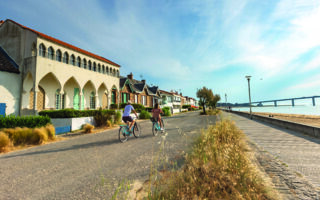Timber Infestation in Buildings


Identification and treatment
Wood Boring Insects infest most properties in Northern France and are commonly but incorrectly generally referred to as ‘woodworm’. In fact most damage to timberwork is in fact caused by the larvae hatched from eggs laid by the flying insects in holes and cracks in the wood, which then eat their way into the timber, pupate and then emerge to start the whole cycle again. Generally Wood Boring Insects can be controlled by Chemical Wood Preservative liquid either, injected or sprayed or painted on the surface of the timber.
Termites are different – they are in fact a type of white ant which eat into the heart of the timber and are very destructive. Termites are common in the South of France, (generally a line South of the Loire) particularly the South West – the Landes having termites in all departments. When a house is sold in affected areas, there is a legal requirement to have the property surveyed (un état parasitaire) for termites. But note that this survey, if it produces a ‘Certificate de non-infestation’ does not guarantee the house is termite free, also it only lasts for a 3 month period! Termites can be controlled by injection of timbers to repel them (it does not kill them) and setting of traps to catch them. Treatment must be carried out by Professional firms and every infestation must by law, be reported to the local Mairie by recorded delivery post.
Common Types of Wood Boring Insects
‘Common Furniture Beetle’
The most common insect damage seen will be the holes of Anobium Punctatum which is the Latin name for the ‘Common Furniture Beetle’. Almost every house in France (and the UK!) has this infestation which is generally not a problem (except down-valuing antique furniture!) unless the infestation is enormous, when the timber can be weakened.
The sight of small holes (approx. 1.5 to 2mm diameter ) which if the insect is active will have sawdust type trails (‘frass’) coming from them indicates treatment is required.
Treatment is usually effective as the chemical used is an insecticide which kills the insect as it lands on the timber. The life cycle is one year, so it is possible that after spraying the frass will still be seen for a time, but no new infestation should occur after 12 months.
‘Death Watch Beetle’ (Xestobium ruforillosum)
Quite common in old houses where there are oak beams. Adult insects are quite often found in the house during the emergence period March to June. The holes are round and much larger than Anobium Punctatum (usually about 3mm dia.) It is quite possible to hear the activity within the timber during quiet periods and sounds like a soft tapping noise.
Treatment is often ineffective as the life cycle of this insect is 4 years. It is best to drill and inject the chemical treatment liquid as well as spraying the timber to get better penetration. Spirit based chemicals are recommended as they also penetrate better than water based treatments.
‘House Longhorn Beetle’ (Hylotrupes bajulus)
This beetle can cause severe structural damage. It is quite large, the adult beetle being up to 25mm and the larvae up to 30mm – they eat a lot! House Longhorn attacks structural timber which crumbles – quite usually this will be your first knowledge that you have this infestation!
The holes are easily identified as they are large (6 to 8mm) and Oval not round.
Treatment is similar to that for Death Watch Beetle.
‘Powder Post Beetle’ (Lyctus brunneus)
This beetle attacks the sapwood of hardwoods like oak, but generally only in newer felled wood as the starch on which it feeds is reduced in older timbers (over 10 years). There will be severe tunnelling in the sapwood running along the grain. This will result in weakened timbers.
The holes are round 1 to 2 mm dia. (same size as Anobium Punctatum)
Treatment, if the attack is not severe – spray and inject where necessary. If severe, timber must be removed and burnt.
There are many other woodboring insects but the above list identifies the most common in the Northern part of France.
Recommendations for Treatment
Which Chemical?
There are broadly three types of chemical treatment available:
Water based emulsion liquid – this can be sprayed and/or painted on wood surfaces (also injected) and penetrates most softwoods and hardwoods sufficiently to control most wood boring beetle infestations. The advantage of this type of chemical is that it is less noxious to humans and animals than spirit based products. Buildings can safely be entered after the product has dried (usually 6 to 8 hours after application) and the product is virtually fume (smell) free. It is less effective against deep boring beetles (for example Death Watch Beetle) as these usually attack denser hardwoods such as oak and require a spirit based chemical to penetrate to a greater depth.
Due to Health and Safety requirements in the UK these chemicals are most usually used by professionals as they are less harmful to humans and animals and cause less damage to decorative finishes.
Spirit Based liquid – as above this can be sprayed or painted on wood surfaces and has a better penetrative ability. But the fumes are noxious and the building should not be entered without a Class 2 chemical mask and protective clothing for up to 48 hours after treatment. In France this chemical is sold freely in retail outlets and Builder Merchants (often under the trade name of Xylophene). If used as a prevention against Death Watch Beetle because of its better penetrative ability, its effectiveness can be improved by drilling the infested wood to a depth of approx. 500mm to 800mm (depending on the size of the beam) and injecting, afterwards plugging the hole with a timber dowel or plastic plug.
Insecticide Plugs and smokes – These products are rarely used on their own by professionals. The plugs are sometimes used for prevention being slow release, as a back-up to spraying. The Smokes are really only a DIY method and are not considered effective in the professional market. (Plugs containing fungicide are however often used against Wood Rot)
In addition to the above, in France many varnishes or lasures contain both fungicide and insecticide and can help prevent infestations starting in new wood, but are ineffective when an infestation has already taken place
The areas to be treated must be cleaned (loose dirt and thick coatings of dust removed by brushing and loose badly infested wood brushed with a wire brush to remove) and dry before application. The timber can be sprayed (using either a low pressure ((Garden sprayer)) or high pressure ((compressor)) spray equipment) a minimum of two good coats are needed, but some manufacturers recommend three coats. If brushing then care must be taken to ensure good cover and penetration is achieved and again two or three coats are required.
NOTE – These chemicals are injurious to health – read to instructions on the containers and adhere to the recommendations for isolation of the building after treatment. Wear protective clothing and appropriate masks whilst treatment is carried out. Keep animals out of the property.
The above treatment can be carried out on a DIY basis, but you should be aware that the only guarantee you will have is that provided by the manufacturer of the product (usually not more than 5 years). It may be very difficult to claim on the guarantee in the event of re-infestation as you will have to be able to prove that you applied the correct number of coats and prepared the timber correctly etc. etc. Usually the most simple route is to re-treat the affected areas.
If you require a better guarantee (10 years) then you will need to use a professional timber treatment company who carry an insurance backed guarantee should they go out of business. In France there are few of these types of Company around, but they are worth seeking out.
Professional Firms have to have a qualification to do the job as they use ‘stronger’ chemicals (up to 3 times the strength of retail products). These chemicals are only sold to registered, qualified companies.
The Professional Firms will require you to vacate the property for a minimum of 48 hours due to health hazard. They themselves will of course be using full protective clothing and breathing equipment. Their equipment is also of industrial power so that penetration will be better.
© Nick Warner
Wellesley House Surveying
Building Surveyor and Timber & Wood Rot Specialist Surveyor.
Share to: Facebook Twitter LinkedIn Email
More in activity, businesses, courses, cycling, garden, insurance, renovation
By FrenchEntrée
Leave a reply
Your email address will not be published. Required fields are marked *




REPLY
REPLY